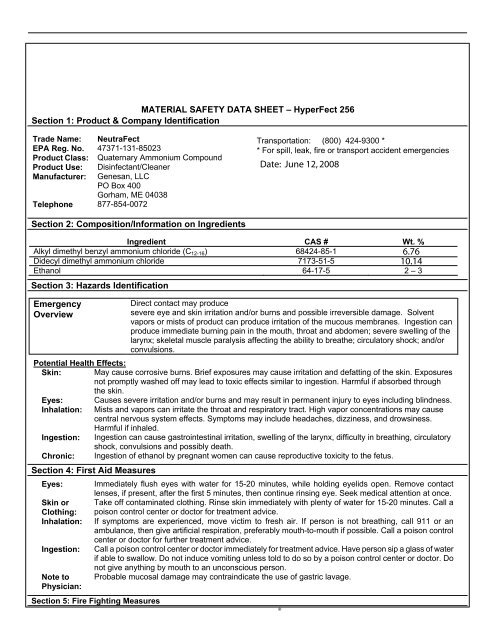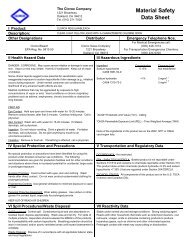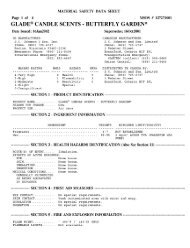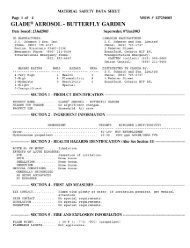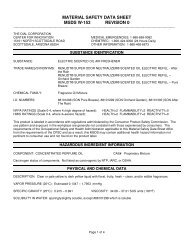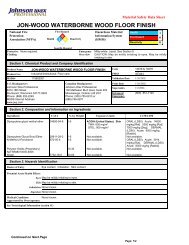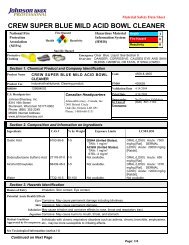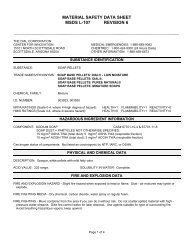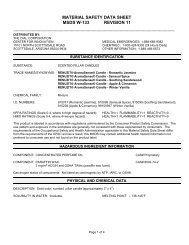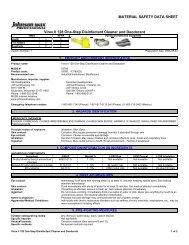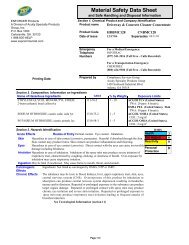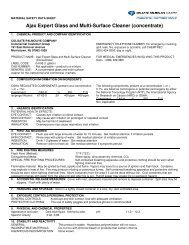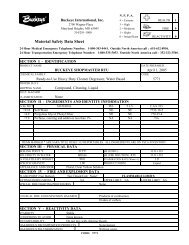MATERIAL SAFETY DATA SHEET – HyperFect 256 - CleanEasier ...
MATERIAL SAFETY DATA SHEET – HyperFect 256 - CleanEasier ...
MATERIAL SAFETY DATA SHEET – HyperFect 256 - CleanEasier ...
You also want an ePaper? Increase the reach of your titles
YUMPU automatically turns print PDFs into web optimized ePapers that Google loves.
<strong>MATERIAL</strong> <strong>SAFETY</strong> <strong>DATA</strong> <strong>SHEET</strong> <strong>–</strong> <strong>HyperFect</strong> <strong>256</strong><br />
Section 1: Product & Company Identification<br />
Trade Name: NeutraFect<br />
EPA Reg. No. 47371-131-85023<br />
Product Class: Quaternary Ammonium Compound<br />
Product Use: Disinfectant/Cleaner<br />
Manufacturer: Genesan, LLC<br />
PO Box 400<br />
Gorham, ME 04038<br />
Telephone 877-854-0072<br />
Section 2: Composition/Information on Ingredients<br />
Ingredient<br />
Alkyl dimethyl benzyl ammonium chloride (C12-16 )<br />
Didecyl<br />
dimethyl<br />
ammonium<br />
chloride<br />
Ethanol<br />
Section 3: Hazards Identification<br />
Emergency<br />
Overview<br />
®<br />
CAS<br />
#<br />
68424-85-1<br />
7173-51-5<br />
64-17-5<br />
Wt.<br />
%<br />
2 <strong>–</strong> 3<br />
Direct contact may produce<br />
severe eye and skin irritation and/or burns and possible irreversible damage. Solvent<br />
vapors or mists of product can produce irritation of the mucous membranes. Ingestion can<br />
produce immediate burning pain in the mouth, throat and abdomen; severe swelling of the<br />
larynx; skeletal muscle paralysis affecting the ability to breathe; circulatory shock; and/or<br />
convulsions.<br />
Potential Health Effects:<br />
Skin: May cause corrosive burns. Brief exposures may cause irritation and defatting of the skin. Exposures<br />
not promptly washed off may lead to toxic effects similar to ingestion. Harmful if absorbed through<br />
the skin.<br />
Eyes: Causes severe irritation and/or burns and may result in permanent injury to eyes including blindness.<br />
Inhalation: Mists and vapors can irritate the throat and respiratory tract. High vapor concentrations may cause<br />
central nervous system effects. Symptoms may include headaches, dizziness, and drowsiness.<br />
Harmful if inhaled.<br />
Ingestion: Ingestion can cause gastrointestinal irritation, swelling of the larynx, difficulty in breathing, circulatory<br />
shock, convulsions and possibly death.<br />
Chronic: Ingestion of ethanol by pregnant women can cause reproductive toxicity to the fetus.<br />
Section 4: First Aid Measures<br />
Eyes: Immediately flush eyes with water for 15-20 minutes, while holding eyelids open. Remove contact<br />
lenses, if present, after the first 5 minutes, then continue rinsing eye. Seek medical attention at once.<br />
Skin or Take off contaminated clothing. Rinse skin immediately with plenty of water for 15-20 minutes. Call a<br />
Clothing: poison control center or doctor for treatment advice.<br />
Inhalation: If symptoms are experienced, move victim to fresh air. If person is not breathing, call 911 or an<br />
ambulance, then give artificial respiration, preferably mouth-to-mouth if possible. Call a poison control<br />
center or doctor for further treatment advice.<br />
Ingestion: Call a poison control center or doctor immediately for treatment advice. Have person sip a glass of water<br />
if able to swallow. Do not induce vomiting unless told to do so by a poison control center or doctor. Do<br />
Note to<br />
Physician:<br />
not give anything by mouth to an unconscious person.<br />
Probable mucosal damage may contraindicate the use of gastric lavage.<br />
Section 5: Fire Fighting Measures<br />
Transportation: (800) 424-9300 *<br />
* For spill, leak, fire or transport accident emergencies<br />
Date: June 12, 2008<br />
6.76<br />
10.14
Flash Point: None when heated to 105 o C <strong>–</strong> Tag Closed Cup<br />
Upper & Lower Flame<br />
Limits<br />
Not determined.<br />
Extinguishing Media: Dry chemical, foam, carbon dioxide, water fog or any other agent suitable for surrounding fire.<br />
Fire Fighting<br />
Firefighters should wear full protective clothing including self-contained breathing<br />
Equipment &<br />
Instructions:<br />
apparatus. Cool fire exposed containers with spray.<br />
Hazardous Combustion<br />
Products:<br />
Irritating and toxic gases or fumes may be released during a fire.<br />
Unusual Fire Explosion<br />
Hazards<br />
Combustion products are toxic.<br />
Section 6: Accidental Release Measures<br />
Spill and Leak Procedures<br />
Emergency Action: Isolate spill or leak area immediately. Keep unauthorized personnel away. Stay upwind. Keep out<br />
of low areas where vapors may accumulate. Eliminate all ignition sources (no smoking, flares,<br />
sparks or flames in immediate area).<br />
Spill Cleanup: Ventilate closed spaces before entering. All equipment used when handling the product must be<br />
grounded. Floor will be slippery. Do not touch or walk through spilled material. Stop leak if you can<br />
do it without risk. Prevent entry into waterways, sewers, basements or confined areas. Absorb or<br />
cover with dry earth, sand or other non-combustible material and transfer to containers.<br />
Large Spills: Dike far ahead of liquid spill for later disposal. Pump into containers for disposal.<br />
Section 7: Handling & Storage<br />
Handling Procedures: Avoid contact with skin and eyes. Use good personal hygiene practices. Wash hands before<br />
eating, drinking, smoking, or using toilet facilities. Wash thoroughly after work using soap and<br />
water.<br />
Storage Procedures: Keep the container tightly closed and in a cool, well-ventilated place. Keep from freezing.<br />
Do not handle or store near an open flame, heat or other sources of ignition. Prevent<br />
electrostatic charge buildup by using common bonding and grounding techniques.<br />
Section 8: Exposure Controls/Personal Protection<br />
Engineering Controls: Provide adequate local exhaust ventilation (explosion proof) to maintain worker exposure<br />
below exposure limits.<br />
Personal Protective Equipment:<br />
Eyes/Face: Wear chemical goggles. Use a face shield if splashing is possible.<br />
Skin: Use impervious gloves (rubber or neoprene). Wear suitable protective clothing.<br />
Respiratory: If exposure limits are exceeded or if irritation is experienced, a NIOSH/MSNA approved<br />
respirator or an organic/vapor removing cartridge respirator protection device should be worn.<br />
Ventilation and other forms of engineering controls are often the preferred means for controlling<br />
chemical exposures. Respiratory protection may be needed for non-routine or emergency<br />
situations.<br />
General: Eye wash fountain and emergency showers are recommended.<br />
The following ingredients have established exposure guidelines:<br />
Ingredient<br />
Ethanol<br />
64-17-5<br />
Exposure<br />
Guideline<br />
ACGIH TLV (2005), OSHA PEL & NIOSH<br />
REL<br />
Alberta, British Columbia, Manitoba, New<br />
Brunswick, Northwest Territories, (Canada)<br />
Guideline<br />
Value<br />
1000 ppm (TWA)<br />
1000 ppm (TWA)<br />
Ontario, Quebec (Canada) 1000 ppm (TWAEV)<br />
Saskatchewan (Canada) 1000 ppm (TWA), 1250 ppm (STEL)<br />
Yukon<br />
( Canada)<br />
Mexico<br />
<strong>MATERIAL</strong> <strong>SAFETY</strong> <strong>DATA</strong> <strong>SHEET</strong> <strong>–</strong> <strong>HyperFect</strong> <strong>256</strong><br />
ACGIH TLV (2005), OSHA PEL & NIOSH<br />
REL<br />
1000<br />
ppm<br />
( TWA)<br />
, 1000<br />
ppm<br />
( STEL)<br />
1000<br />
ppm<br />
( TWA)<br />
1000 ppm (TWA)
All TWAs are for an 8-hour period and all STELs are for 15 minutes unless specifically noted as being for another time period.<br />
Section 9: Physical & Chemical Properties<br />
Flash Point: None when heated to 105 o C <strong>–</strong> Tag Closed Cup<br />
Specific Gravity: 1.006 (8.35lbs/gal)<br />
Percent Volatiles: Not determined.<br />
Vapor Pressure: Not determined.<br />
VOC Content ~ 20<br />
Vapor Density: Estimated to be heavier than air.<br />
Viscosity: 13.61 mm 2 /s (cSt) @ 22 o C<br />
Evaporation Rate: Not determined.<br />
Pour Point: Not determined.<br />
pH : 7.31<br />
Appearance and Odor: Clear, colorless to straw colored liquid with benzaldehyde (organic) odor.<br />
Section 10: Stability & Reactivity<br />
Chemical Stability: Material is stable.<br />
Conditions to Avoid: Keep away from heat and strong oxidizing agents.<br />
Incompatibilities: Strong oxidizing agents (may result in fire.), reducing agents.<br />
Hazardous Decomposition: Carbon monoxide, carbon dioxide and toxic hydrogen chloride vapors.<br />
Hazardous Polymerization: Will not occur.<br />
Section 11: Toxicological Information<br />
Carcinogenicity No Carcinogenicity data available for this product.<br />
Acute Oral LD50 >1500 mg/kg for male and female rats.<br />
Acute Dermal LD50 >2000 mg/kg for male and female rabbits.<br />
Primary Skin Severe irritant, corrosive.<br />
Primary Eye Severe irritant.<br />
Chemicals Ingredients Listed as Potential or Known Carcinogens<br />
Ingredient<br />
OSHA<br />
No<br />
ingredients<br />
listed<br />
in<br />
this<br />
section.<br />
Section 12: Ecological Information<br />
Ecotoxicity No data available for this product but it is considered toxic to fish.<br />
Section 13: Disposal Considerations<br />
Disposal Instructions<br />
This substance, when discarded or disposed of, is a characteristic hazardous waste according to Federal regulation (40 CFR<br />
261) and is assigned the EPA Hazardous Waste Number of D001. The discarding or disposal of this material must be done at a<br />
properly permitted facility in accordance with the regulations of 40 CFR 262, 263, 264, and 268. Additionally, the discarding or<br />
disposal of this material may be further regulated by state, regional, or local regulations. Chemical additions, processing or<br />
otherwise altering this material may make the waste management information presented in this MSDS incomplete, inaccurate<br />
or otherwise inappropriate.<br />
The transportation, storage, treatment and disposal of this waste material must be conducted in compliance with all applicable<br />
Federal, state, and local regulations.<br />
Section 14: Transport Information<br />
NTP<br />
IARC<br />
DOT Hazard Class 8 Corrosive<br />
DOT Proper Shipping Name Disinfectant Liquid Corrosive, NOS (Quaternary Ammonium Compound), 8, UN1903,<br />
PG III<br />
Section 15: Regulatory Information<br />
<strong>MATERIAL</strong> <strong>SAFETY</strong> <strong>DATA</strong> <strong>SHEET</strong> <strong>–</strong> <strong>HyperFect</strong> <strong>256</strong><br />
TSCA Status<br />
While all ingredients are listed on the TSCA Chemical Inventory, this product is regulated as a pesticide under the Federal<br />
Page 3 of 4
Insecticide, Fungicide and Rodenticide Act (FIFRA) and not subject to the TSCA Inventory rules for FIFRA uses.<br />
Other Chemical Inventories<br />
All components of this product are listed on the following inventories: Canada (DSL), China, and Philippines. One or more<br />
ingredients are not listed on the following inventories: Australia, European Union, Japan and Korea.<br />
CERCL/SARA<br />
SARA Title III, Sections 311/312 <strong>–</strong> This act requires reporting under the Community Right-to-Know provisions due to the<br />
inclusion of the following components of this material in one or more of the five hazard categories listed in the 40 CFR 370:<br />
Classification of this product: Immediate, Fire<br />
SARA Title 313 <strong>–</strong> This act requires submission of annual reports of releases of the following components of this material if<br />
the threshold reporting quantities, as listed in 40 CFR 372, are met or exceeded:<br />
Maximum<br />
Chemical Name<br />
No ingredients listed in this section.<br />
CAS No.<br />
Concentration Comment<br />
Reportable Quantities/Threshold Planning Quantities: CERCLA requires notification of the National Response<br />
Center (Telephone 1-800-424-8802) in the event of a release of quantities of the following hazardous materials<br />
contained in this product, if the release is equal to or greater than the Reportable Quantities (RQs). SARA 302/304<br />
requires emergency planning, including agency notification, for possible release of the following components of this<br />
material, based upon the Threshold Planning Quantities (TPQs) and/or release of Reportable Quantities.<br />
Chemical<br />
Name<br />
Reportable<br />
Quantity<br />
( RQ)<br />
Threshold<br />
Planning<br />
Quantity<br />
( TPQ)<br />
No<br />
ingredients<br />
listed<br />
in<br />
this<br />
section.<br />
State & Provincial Right to Know & Selected Regulatory Lists<br />
The following ingredients appear on various state right to know lists and/or California’s Proposition 65 List<br />
Chemical Name State List<br />
Benzyl Chloride (trace < 100 ppm) AZ, CA, CAP65C, CT, IL, MA, MN, NJ, PA, RI<br />
Ethanol<br />
AZ,<br />
CA,<br />
CAP65R<br />
( ingestion<br />
only)<br />
, CT,<br />
ID,<br />
MA,<br />
MN,<br />
NJ,<br />
PA,<br />
RI<br />
AZ <strong>–</strong> Arizona Ambient Air Quality Guidelines<br />
IL <strong>–</strong> Illinois Toxic Air Contaminant - Carcinogenic<br />
CT <strong>–</strong> Connecticut Hazardous Air Pollutants<br />
MA <strong>–</strong> Massachusetts Right to Know List<br />
CA <strong>–</strong> California Director’s List of Hazardous Substances MN <strong>–</strong> Minnesota Hazardous Substances List<br />
CA65C <strong>–</strong> California Prop 65 Carcinogen<br />
NJ <strong>–</strong> New Jersey Right to Know List<br />
CA65R <strong>–</strong> California Prop 65 Reproductive Toxin<br />
PA <strong>–</strong> Pennsylvania Right to Know List<br />
ID <strong>–</strong> Idaho Non-carcinogen Toxic Air Pollutants<br />
RI <strong>–</strong> Rhode Island Hazardous Substances List<br />
WHMIS Classification: E, D2B. This product has been classified in accordance with hazard criteria of the Controlled<br />
Products Regulations and the MSDS contains all the information required by the Controlled<br />
Products Regulations.<br />
Section 16: Other Information<br />
Current Issue Date: August, 2007<br />
Previous Issue Date: None<br />
Changes from Previous Issue Date: New MSDS<br />
Hazard Ratings HMIS (II) NFPA<br />
Health 3 3<br />
Flammability 0 0<br />
Reactivity 0 0<br />
PPE X<br />
Disclaimer<br />
<strong>MATERIAL</strong> <strong>SAFETY</strong> <strong>DATA</strong> <strong>SHEET</strong> <strong>–</strong> <strong>HyperFect</strong> <strong>256</strong><br />
Disclaimer: Nothing contained herein grants or extends a license, express or implied, in connection with patents, issued or pending, of the manufacturer or<br />
others. The information contained herein is based on the manufacturer’s own study and the works of others. The manufacturer makes no warranties,<br />
expressed or implied, as to the accuracy, completeness, or adequacy of the information contained herein. The manufacturer shall not be held liable<br />
(regardless of fault) to the vendee’s employees, or anyone for any direct, special or consequential damages arising out of or in connection with the accuracy,<br />
completeness, adequacy or furnishing of such information. The buyer assumes all risks of the use and/or handling.<br />
Page 4 of 4


